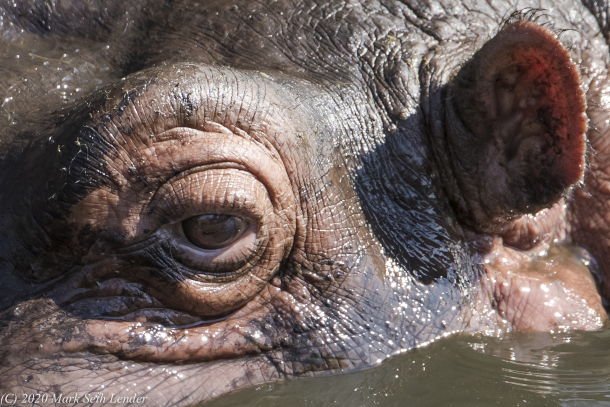Scylla and Charybdis on the Zambezi River
Air Date: Week of October 2, 2020

A hippopotamus on the Zambezi River, perhaps too close for comfort. (Photo: (c) Mark Seth Lender)
Living on Earth’s Explorer-in-Residence Mark Seth Lender recounts a hair-raising encounter with hippopotamus and Cape buffalo on the Zambezi River and in Hwange National Park, Zimbabwe.
Transcript
CURWOOD: The plains of Southern Africa are famous for its wildlife – elephants, buffalo, and hippo to name a few. Living on Earth’s Explorer in Residence Mark Seth Lender shares this story of a close encounter with some of the most dangerous.
Scylla and Charybdis
Hippopotamus & Cape Buffalo
Zambezi River & Hwange National Park
© Mark Seth Lender
All Rights Reserved
Not the thing you want to hear in a narrows.
“HIPPOS ON THE RIGHT!”
Valerie and me we dig in, double stroke, driving up against the bank so hard there’s dirt and leaves and rocks falling into the canoe, listing to twenty degrees, partway on land and too much of the rest of us in the river.
While the hippos continue straight for us.
Not because they want to get us but because they have a point to make:
“This river is my land it isn’t your land if I were you I’d scram for the highlands – ”
When it looks like we are going to make it and just in the nick of time, there on the bank above and only a few strokes away is an extended family of cape buffalo, staring down, and not in a friendly way. The bulls are close enormous solid as hardwood and they are scowling, their horns lowered, heads turned in unison to look across their shoulders, at us; point being the same one the hippopotamus made:

Cape buffalo are known to be strong and dangerous. They can weigh about 2,000 pounds and be about 5 to 6 ft long and 5 to 6 ft tall. (Photo: (c) Mark Seth Lender)
Get your faces out of here!
And you could have water skied behind our canoe that morning on the Zambezi.
Ten days later, we are on foot in Hwange with Albert Paradzai (one of the best guides we have ever had on any continent) and he says in a marvelously normal tone of voice, “Folks there’s danger behind us.”
This time, elephants. They don’t have it in for us (not like the hippos did) but they are thirsty, and in a hurry, thinking only about reaching the nearby waterhole, and we are standing in the way.
And in front of us?
Cape buffalo. An entire bachelor herd, fifty at least, maybe sixty. They stop and stare the way the first ones did, over their shoulders, heads lowered (Mack trucks on hooves) and nothing but flat ground between them and us. We crowd so close together we are practically in the same set of boots. And instead of leading us to safety (not that there is anywhere safe to go) Albert grabs his rifle in both hands, raises it over his head like in the movies when the platoon is about to ford a stream that everyone knows is probably mined, and smiles, and says, “We can’t just leave without saying hello!”

Elephant herd heading for water. (Photo: (c) Mark Seth Lender)
And he runs straight toward them and what the hell are we going to do except follow. Into the Whirlwind.
To our amazement, the herd parts, like Albert is Moses and they are the Red Sea, and they run away.
And stop.
And look. A lot less sure of themselves, this time.
“They think I have a bigger set of horns,” Albert says, meaning the rifle, “and they find that verrrry scary.”
And takes another run at them.
How frequently in life we fear when there is no need, and ignore what should scare us.
CURWOOD: That’s Living on Earth’s Explorer in Residence Mark Seth Lender.
Links
Living on Earth wants to hear from you!
Living on Earth
62 Calef Highway, Suite 212
Lee, NH 03861
Telephone: 617-287-4121
E-mail: comments@loe.org
Newsletter [Click here]
Donate to Living on Earth!
Living on Earth is an independent media program and relies entirely on contributions from listeners and institutions supporting public service. Please donate now to preserve an independent environmental voice.
NewsletterLiving on Earth offers a weekly delivery of the show's rundown to your mailbox. Sign up for our newsletter today!
 Sailors For The Sea: Be the change you want to sea.
Sailors For The Sea: Be the change you want to sea.
 The Grantham Foundation for the Protection of the Environment: Committed to protecting and improving the health of the global environment.
The Grantham Foundation for the Protection of the Environment: Committed to protecting and improving the health of the global environment.
 Contribute to Living on Earth and receive, as our gift to you, an archival print of one of Mark Seth Lender's extraordinary wildlife photographs. Follow the link to see Mark's current collection of photographs.
Contribute to Living on Earth and receive, as our gift to you, an archival print of one of Mark Seth Lender's extraordinary wildlife photographs. Follow the link to see Mark's current collection of photographs.
 Buy a signed copy of Mark Seth Lender's book Smeagull the Seagull & support Living on Earth
Buy a signed copy of Mark Seth Lender's book Smeagull the Seagull & support Living on Earth

